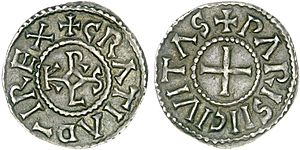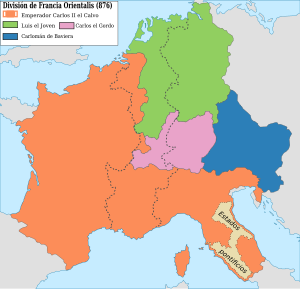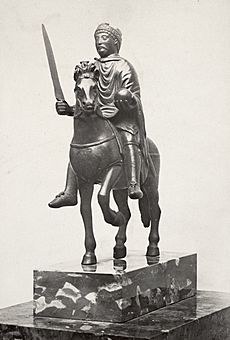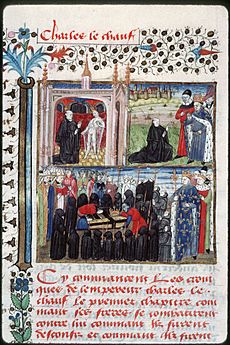Charles the Bald facts for kids
Quick facts for kids Charles the Bald |
|
|---|---|
| Emperor of the Romans | |
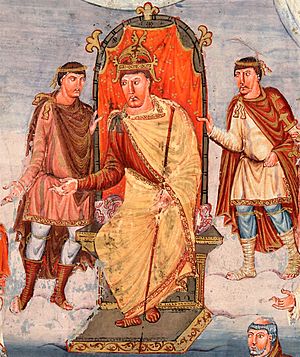
Charles the Bald as depicted in the Vivian Bible, c. 845
|
|
| Emperor of the Carolingian Empire King of Italy |
|
| Reign | 875 – 6 October 877 |
| Coronation | 25 December 875, Pavia |
| Predecessor | Louis II the Younger |
| Successor | Charles III the Fat (Emperor) Carloman of Bavaria (Italy) |
| King of West Francia | |
| Reign | 20 June 840 – 6 October 877 |
| Predecessor | Louis I the Pious as King of the Franks |
| Successor | Louis II the Stammerer |
| Born | 13 June 823 Frankfurt |
| Died | 6 October 877 (aged 54) Brides-les-Bains |
| Burial | Abbey of Saint-Denis |
| Spouse | |
| Issue |
|
| House | Carolingian |
| Father | Louis the Pious |
| Mother | Judith of Bavaria |
Charles the Bald (born 13 June 823 – died 6 October 877) was an important ruler in the 9th century. He was the King of West Francia from 843 to 877. This kingdom was mostly what we now call France. He also became the King of Italy and the Emperor of the Carolingian Empire from 875 to 877.
Charles was a grandson of the famous Charlemagne. He was the youngest son of Emperor Louis the Pious and his second wife, Judith. After his father's reign, there were many civil wars. Charles eventually gained the western part of the empire through the Treaty of Verdun in 843.
Contents
Becoming King: A Family Struggle
Charles was born in Frankfurt on 13 June 823. His older brothers were already grown up and had their own parts of the empire. His father, Louis the Pious, tried to give Charles his own land. But these attempts were not very successful.
His brothers, Lothair, Pepin, and Louis the German, often rebelled. This made Charles's share of land uncertain. However, his father kept trying to make Charles his main heir. In 837, at a meeting in Aachen, nobles promised loyalty to Charles.
When Pepin of Aquitaine died in 838, Charles finally received that kingdom. This made Pepin's heirs and the local nobles angry.
The War of the Brothers
When Emperor Louis the Pious died in 840, a war broke out among his sons. Charles teamed up with his brother Louis the German. They fought against their older brother, Emperor Lothair I. The two allies defeated Lothair at the Battle of Fontenoy-en-Puisaye on 25 June 841.
The next year, Charles and Louis made their alliance stronger with the famous Oaths of Strasbourg. This war ended with the Treaty of Verdun in August 843.
Dividing the Empire
The Treaty of Verdun split the Carolingian Empire into three parts:
- Charles the Bald received the western part, called the Kingdom of the West Franks. This area is mostly modern-day France.
- Louis the German received the eastern part, which became known as East Francia (later Germany).
- Lothair I kept the title of Emperor and the Kingdom of Italy. He also got the central lands, from Flanders through the Rhineland and Burgundy. This was called Middle Francia.
Charles's Rule in the West
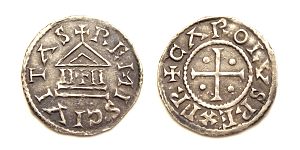
After the Treaty of Verdun, Charles had a few peaceful years until Lothair I died in 855. During this time, the three brothers often met to govern together.
In 858, Louis the German invaded Charles's kingdom. Some unhappy nobles had invited him. Charles was so unpopular that he could not gather an army. He had to flee to Burgundy. He was saved by the support of bishops and his mother's family, the Welfs.
Later, in 869, Charles tried to take over the lands of his nephew, Lothair II, who had died. He was crowned King of Lotharingia at Metz. But he had to negotiate with Louis the German. In 870, they divided Lotharingia in the Treaty of Mersen.
Fighting Rebellions and Vikings
Charles also faced many challenges within his own kingdom. There were frequent rebellions in Aquitaine and from the Bretons. The Bretons, led by Nomenoë and Erispoë, defeated Charles in battles. They managed to gain a lot of independence.
Charles also had to fight against the Vikings. These fierce raiders attacked the northern parts of his country. They sailed up the Seine and Loire rivers. In 845, the Vikings successfully attacked and looted Paris. Charles often had to pay them a lot of money to make them leave.
To fight the Vikings, Charles made his army stronger. In 864, he issued the Edict of Pistres. This law made the army more mobile by adding cavalry (soldiers on horseback). This was an early step towards the famous French chivalry. The edict also ordered the building of fortified bridges over rivers. These bridges helped stop Viking ships. Two of these bridges in Paris helped save the city during a long Viking attack in 885–886.
Charles also engaged in diplomacy. In 865, he received camels from Emir Muhammad I of the Emirate of Cordoba. From the 860s, the palace of Compiègne became a very important place for Charles. He founded a monastery there in 876. Later, Compiègne was even called 'Carlopolis' because of its connection to Charles.
Becoming Emperor
In 875, his half-brother Lothair's son, Emperor Louis II, died. Charles the Bald, with the support of Pope John VIII, traveled to Italy. He received the royal crown in Pavia and the imperial crown in Rome on 25 December.
As emperor, Charles used a special motto on his seal: renovatio imperii Romani et Francorum. This means "renewal of the empire of the Romans and Franks."
Louis the German also wanted to be emperor. He got revenge by invading Charles's lands. Charles had to rush back to West Francia. After Louis the German died in 876, Charles tried to take over Louis's kingdom. But he was badly defeated at the Battle of Andernach on 8 October 876.
Meanwhile, Pope John VIII was being threatened by the Saracens (Muslims). He asked Charles to come and defend Italy. Charles crossed the Alps again. However, his nobles and even his regent in Lombardy, Boso, were not enthusiastic. They refused to join his army. At the same time, Carloman, Louis the German's son, entered northern Italy.
Charles became very ill and distressed. He started his journey back to Gaul. But he died while crossing the Mont Cenis pass at Brides-les-Bains on 6 October 877.
Burial and Legacy
Charles was quickly buried at the abbey of Nantua in Burgundy. This was because his body was decaying quickly. A few years later, his remains were moved to the Abbey of Saint-Denis. This was where he had always wanted to be buried. His body was placed in a porphyry tub. This tub might be the same one known as "Dagobert's tub," which is now in the Louvre museum.
Charles was succeeded by his son, Louis. Charles was known for supporting education and learning. He was also a friend of the church. He often chose his advisors from important church leaders.
Why "the Bald"?
It's interesting that Charles was called "the Bald." Some historians think this nickname was used as a joke, not because he was actually bald. They suggest he might have been very hairy instead!
Another idea is that "Bald" referred to his initial lack of land. When he was young, his older brothers already had their own kingdoms. Charles had to wait a long time to get his own. So, "Bald" could have meant "landless."
Pictures from his time, like in his Bible of 845 and on his seals, show him with a full head of hair. The equestrian statuette (around 870), which many believe shows him, also depicts him with hair.
However, a text from around 869, called the Genealogy of Frankish Kings, clearly calls him Karolus Calvus ("Charles the Bald"). Later writers in the 10th century also seriously referred to him as "Charles the Bald." So, the exact reason for his nickname is still a bit of a mystery!
Family Life
Charles married Ermentrude in 842. She was the daughter of Odo I, Count of Orléans. Ermentrude died in 869. In 870, Charles married Richilde of Provence. She came from a noble family in Lorraine.
With Ermentrude, Charles had several children:
- Judith (born around 843 – died after 866). She married three kings of Wessex.
- Louis the Stammerer (846–879)
- Charles the Child (847–866)
- Lothair the Lame (848–866), who became a monk.
- Carloman (849–876)
- Rotrude (852–912), a nun.
- Ermentrud (854–877), a nun.
- Hildegarde (born 856, died young)
- Gisela (857–874)
- Godehilde (864–907)
With Richilde, Charles had these children:
- Rothilde (871–929)
- Drogo (872–873)
- Pippin (873–874)
- A son (born and died 875)
- Charles (876–877)
See also
- First Bible of Charles the Bald
- Crown of Charlemagne
- Capitularies of Charles the Bald
- Engelram, Chamberlain of France
 In Spanish: Carlos el Calvo para niños
In Spanish: Carlos el Calvo para niños


